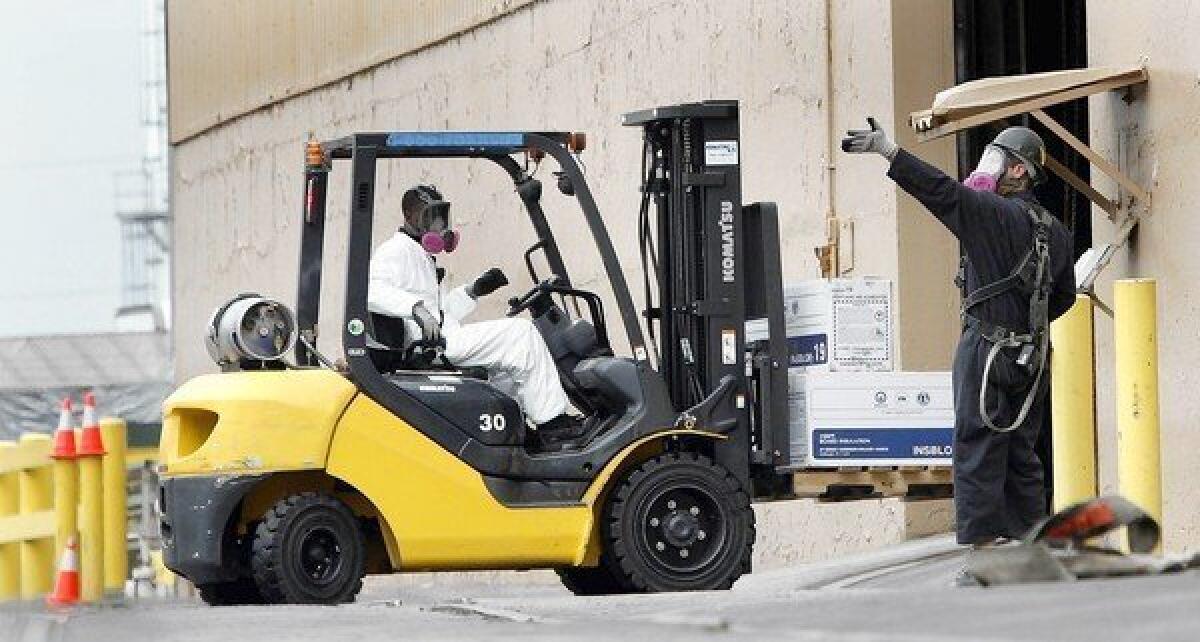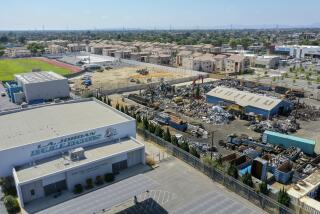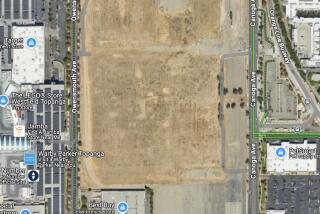Battery recycler Exide’s problems aren’t just local

Since she was 13, Tiffany Arroyo lived with the smoke and rotten-egg smell from an Exide battery-recycling plant just blocks from her grandparents’ home in Laureldale, Pa.
“It was horrible, just horrible, to go outside and smell it,” Arroyo, now 30, said of the recently idled facility. “And the stuff that came out of the chimney, you could see it just everywhere for miles. In the morning, you’d have dust on the car, like gray dust, and it would cover the grass.”
So much lead dust poured from the plant, which Exide acquired in the 1980s, that it contaminated hundreds of residential properties including her grandparents’ yard.
The emissions prompted the 1996 closure of a nearby park and lake, which only recently reopened. Exide has removed tainted soil from the 25-acre park, but Arroyo said she still won’t take her 6-year-old daughter there to play.
“I don’t think I ever will,” she said.
Exide Technologies, one of the world’s largest makers and recyclers of lead-acid batteries, has left a trail of pollution and health worries across the country. Since last November, it has closed or suspended operations at three U.S. recycling operations in the face of public and political pressure. Over the years, it has left communities struggling with decades-old contamination and questioning why regulators didn’t act sooner.
The Georgia-based company, which operates in more than 80 countries and had net sales of $3.1 billion last year, continues to recycle batteries in Missouri and Indiana after halting operations at plants in California, Pennsylvania and Texas. It also manufactures batteries in seven states, according to its website.
In April, California officials suspended operations at an Exide lead recycler — or smelter — in Vernon, citing emissions of arsenic as a health risk to 110,000 people in surrounding communities. Regulators said the plant, which for years also discharged harmful quantities of lead, posed a higher cancer risk to more people than any of the more than 450 regulated facilities in Southern California in the last 25 years.
Since 2010, seven Exide operations have been linked to ambient airborne lead levels that posed a health risk, a Times review of EPA and local and state government data showed. The areas in which Exide was found to be a significant source of lead included Los Angeles; Frisco, Texas; Muncie, Ind.; Salina, Kan.; Bristol, Tenn.; Reading, Pa., and Forest City, Mo.
That is about a third of all such areas identified by the EPA in the country during that period.
Exide officials say the company works hard to protect public health and the environment, while recycling millions of batteries for cars, boats and heavy equipment. The company spends “millions of dollars a year monitoring and remediating problems,” and has retrofitted recycling facilities to keep up with new regulatory standards, spokeswoman Susan Jaramillo said, adding that the company takes its obligations “very seriously.”
“When environmental problems have been identified, Exide has worked with regulators to identify, design and implement appropriate remedies within agreed-upon time frames,” she said.
In recent years, the Laureldale plant was fined about $500,000 by environmental-protection and occupational-safety agencies for failing to monitor lead emissions and other violations.
Arsenic and cadmium were found in the soil, said Mark Scott, a Berks County commissioner, who told state regulators in a 2009 letter that Exide’s legacy was “one of the greatest environmental catastrophes in the history of Berks County.”
Lead can damage the kidneys as well as the nervous and reproductive systems. Children are more vulnerable than adults and can suffer learning disabilities even with limited exposure. Arsenic, a carcinogen, can also cause nausea, decreased blood-cell production and abnormal heart rhythm.
Still, it can be nearly impossible to prove a direct link between illnesses and a particular source of toxics. Some health effects accumulate over decades and can be difficult to isolate from other harmful exposures. As a result, many people are left with suspicions about what caused their illnesses, but can’t prove it.
“The people in that community are worn down and discouraged,” Scott said of Laureldale, a working-class borough near Reading. “To a large measure, they’ve just given up.”
When the plant’s state air-quality permits were renewed in 2010, he and other county officials appealed to Pennsylvania’s Environmental Hearing Board for tougher restrictions and better monitoring. Scott said he thought the state Department of Environmental Protection, which issued the permits, was afraid of killing jobs.
Exide once planned to spend millions on improving lead-containment systems at the plant. But after the county mounted its two-year legal challenge to its permits, the company chose to idle the facility, lay off 150 workers and shift work to other smelters, including Vernon.
Jaramillo said Exide’s decision was based on business considerations, including the volatile prices of lead and spent batteries.
The Laureldale smelter’s future is unclear. The same is true of the Vernon plant, which recycled batteries for 91 years, the last 13 under Exide’s ownership. Exide is fighting the state’s temporary closure order.
The arsenic emissions and wastewater-pipeline leakage were but the latest in a series of pollution problems that have posed a risk to residents of nearby Boyle Heights and Maywood. Regulators have also accused the facility of allowing lead dust to fall on neighboring rooftops and streets.
“I think it’s unconscionable,” said Msgr. John Moretta of Resurrection Catholic Church, a Boyle Heights parish that has sought changes at the plant. He said residents have complained of burning eyes, asthmatic children and other potentially more serious effects.
Regulators found serious violations of air or hazardous waste rules at the Vernon plant almost every year since 2002. State toxics officials did not suspend operations until April, after The Times reported on the arsenic emissions.
The air district estimated that emissions from the Vernon plant would create a risk of about 156 cancer cases per million people among nearby workers over decades of exposure. For people farther away in Boyle Heights, the risk was put at about 22 per million.
Under district regulations, the public must be warned when risk from a facility reaches 10 per million. The first of several public meetings on the risks are to begin Thursday in Huntington Park.
Exide’s Jaramillo said the company has “taken a number of actions” at the Vernon plant to comply with air standards, including adding scrubbers and filters and enclosing the facility.
Exide plants elsewhere also have been cited repeatedly for failing to comply with air and water pollution rules.
Tennessee’s Department of Environment and Conservation has found multiple violations at the Bristol manufacturing plant since 2008, including exceeding production limits designed to minimize lead emissions. At its Muncie smelter recently, discharges were found to be killing nearby vegetation.
In the Central Valley community of Visalia, the pollution from an Exide plant still hasn’t been fully cleaned up — nearly a quarter-century after its closure.
Exide suddenly shut down its battery-making plant after a fire in 1990, leaving behind a large volume of soil tainted with lead, records show. In the late 1980s, tests showed lead levels in some areas that were thousands of times what the government considers acceptable.
In 1998, the state toxics department and Exide signed a consent agreement to clean it up but the work was delayed when the company filed for bankruptcy protection in 2002, according to records and interviews.
Finally, in 2011, Exide, which sold the property in 1999, paid $450,000 in cleanup costs. State officials said they hope work will be completed next year.
Many lead smelters began operating decades ago, when surrounding areas were lightly populated. Frisco, a booming suburb of Dallas, had fewer than 2,000 people when the battery plant opened in the1960s. More than 130,000 people lived there when the facility closed late last year.
“The fallout of that plant over a 50-year period was just massive — tons and tons and tons of lead,” said Jim Schermbeck, a director of Downwinders at Risk, an environmental group.
Not only did lead dust rain from the plant’s smokestacks and seep into the soil, he and others said, but tons of hazardous waste were dumped in landfills and lead-tainted battery casings were broken up and used as road bed, only to crop up decades later.
“In Frisco, they literally paved the streets with this stuff,” Schermbeck said.
State and federal inspectors in recent years found a raft of violations at the Exide site, including hazardous waste leaking into a creek that feeds a lake that is a source of drinking water.
Exide developed plans to address the problems. But Frisco cut a deal with the company to raze the plant and clean up the site. In return, it agreed to pay $45 million to buy and redevelop 180 acres of Exide land in a “buffer zone” around the facility.
Some Frisco residents said they were delighted to see Exide go, but doubt the company will fully clean up.
“Do I have any faith in Exide? Absolutely not,” said Eileen Canavan, a local resident turned activist.
More to Read
Sign up for Essential California
The most important California stories and recommendations in your inbox every morning.
You may occasionally receive promotional content from the Los Angeles Times.











